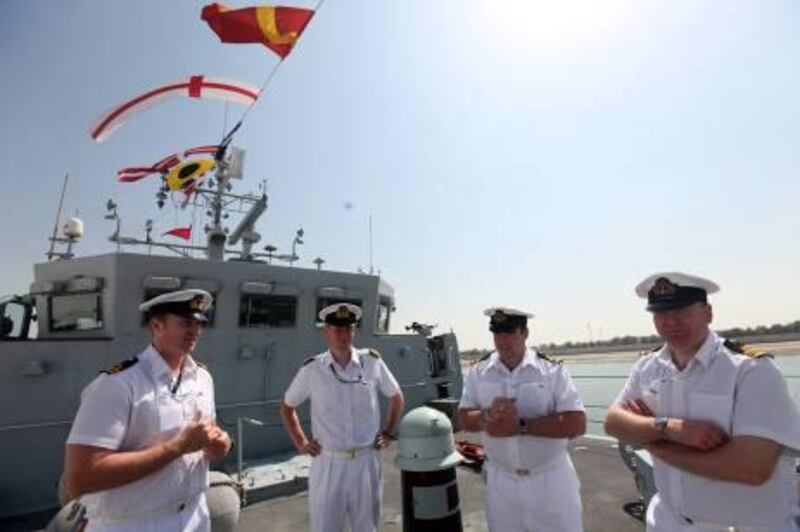ABU DHABI // British sailors at the Naval Defence Exhibition in the capital this week revealed how they rescued Yemeni merchants from Somali pirates.
The South Korean merchant vessel Yong Jin was captured by 17 Somali pirates in November and turned into a "mother ship".
HMS Cornwall is the flagship of CTF-151, an international naval taskforce that combats piracy. When Cornwall sailed into nearby waters, the Yemeni crew on board had been held hostage for 92 days.
Lt James Walton, the on-watch principal warfare officer, said the Cornwall was conducting a routine patrol in an area where pirates were known to operate when he was called to the bridge.
“We saw a dhow acting suspiciously in the vicinity of a merchant vessel,” he said.
______________
[ UAE hosts global summit on piracy threat ]
______________
The “tripwires” that spark suspicions of a possible pirate hijacking include “pirate paraphernalia” such as bent-over ladders with rounded tops that pirates use to hook on to ships, the sailors say. Other signs of piracy are grappling hooks, fuel barrels, skiffs and a large number of people on board the boat.
“It’s an accumulation and a feeling you get over time operating in the area to decide whether ‘yeah, we actually think this is of interest’,” said Lt Walton.
The Cornwall launched a helicopter that flew ahead to gather more information.
What happened next was a well-trodden path of military protocol: the ship transmitted information to the British marine command and the commodore leading the Cornwall.
"We were able to deploy our royal marine boarding team and subsequently the take-down," said Lt Ollie Hocker, the Cornwall's navigating officer. "It sort of happens very quickly."
Surprised by the emergence of a warship behind them, the Somali pirates complied without any violence.
The Cornwall can deploy a boarding team to a ship overtaken by pirates within 30 minutes.
As the royal marines were put on boats and deployed, the Cornwall moved closer to the ship, and the ship's Somali interpreter attempted to speak to the pirates.
“We were able to talk to them, and they were very compliant, and they all moved to the front of the vessel, and they all put their hands in the air, and from that point we had the upper hand,” said Lt Hocker.
The negotiations were necessary before boarding to ensure the safety of troops as well as the safety of the Yemeni merchants, the sailors said.
Lt Walton said the speed with which the ship’s anti-piracy measures were deployed surprised the pirates, overwhelming them into submission.
“I think they saw us late because we came up from behind the merchant men and they just saw a warship on the horizon, and the speed of our action to get in there and dominate the area worked in our favour very well,” he said.
“They weren’t prepared to put up a fight,” said Lt Hocker.
However, the sailors said that anti-piracy capabilities were limited because of the size of the sea.
“We can’t be everywhere, we do our best but the merchant marine have to help themselves with as many measures as they can take,” said Lt Com Susie Thomson, a media operations officer at the Royal Navy and Combined Maritime Forces.
International naval forces are tasked with patrolling about 2.5 million square miles of sea.
Pirate tactics were evolving as well, the sailors said. For instance, pirates regroup during the monsoon season, when they are unable to carry out any attacks, lulling security forces into a false sense of calm. The pirates then come back with new tactics.
New technology such as American Predator drones may be introduced in the fight against piracy near the Gulf of Aden. The drones could be beneficial, the sailors said, but the international coalition still needed to make decisions about where to position assets.
The message to merchants was to “be on your guard throughout the Indian Ocean”, said Lt Com David Griffin.
The Somali pirates were returned to Somalia, and the sailors said they were satisfied with the result of their mission, saying they probably managed to disrupt the pirates’ ability to conduct future attacks.
“They have to start all over again,” said Lt Hocker. “And they have a command structure as well, they are actually failed pirates. So they have to report back to Somalia with no weapons, no skiffs, no engines, no pirated vessel.”
Britain deemed it inappropriate to continue to detain the pirates. International law makes it difficult to prosecute pirates unless they are caught engaging in an act of piracy. However, countries including Kenya and Seychelles have begun efforts to prosecute pirates.
The crew of the Cornwall found long-barrel guns, Kalashnikov bearings, a rocket-propelled grenade launcher and a small grenade launcher on board.
“To be able to set five Yemenis off, watch them sail into the sunset, being freed of 17 Somalis on board and having found weapons ... to know we’ve eradicated that pirate for the best part of how long it takes them to regenerate is a good story,” said Lt Hocker.







